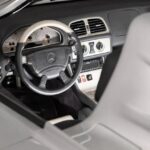Navigating the world of Bluetooth adapters for a Mercedes Benz can be surprisingly frustrating, especially when you expect seamless integration in a luxury vehicle. My personal experience with aftermarket options, specifically the VISEEO brand, has been far from ideal, and it’s a journey I feel compelled to share for fellow Mercedes owners considering Bluetooth upgrades.
My quest for a reliable Mercedes Benz Bluetooth Adapter began with high hopes and an iPhone 6S Plus. The VISEEO brand was frequently mentioned, so I decided to try both their 1000 and 3000 models. Right from the start, issues arose. These adapters seemed to constantly fight with the factory-installed Bluetooth in my Mercedes. During phone conversations, any slight lag would trigger the VISEEO to attempt intervention, creating a disruptive and unreliable connection. Despite multiple attempts, a stable connection was consistently elusive. While these adapters might function adequately for music streaming during solo drives, the moment you need to make or receive calls, the quirks become glaringly obvious. To avoid constant frustration, I found myself disconnecting the VISEEO adapter whenever I wasn’t actively using it.
Another significant drawback I discovered is that the VISEEO adapter remains powered even when the car is turned off. This parasitic drain, while minimal, raises concerns about battery life, especially if the vehicle is left unused for extended periods. My experience with another vehicle taught me that even a charger light left plugged in can slowly deplete the battery over time. This constant power draw from the VISEEO is definitely something to consider.
Steering wheel controls are advertised as compatible, but the reality is a sluggish and often glitchy experience. Navigating menus via the steering wheel interface is painfully slow. Attempting to scroll too quickly often results in system freezes or, bizarrely, the appearance of Chinese characters on the Comand screen. This unresponsiveness makes using the steering wheel controls for the Bluetooth adapter more trouble than it’s worth.
In my search for a working solution, the only Mercedes Benz Bluetooth adapter that has proven reliable is surprisingly simple: the official Apple OEM 30-pin to Lightning adapter. It’s crucial to use the genuine Apple adapter; knock-off versions I tested were completely ineffective and even triggered screen errors. While this Apple adapter technically works, controlling it from the driver’s seat in my Mercedes is ergonomically challenging, requiring long arms to reach comfortably.
Disappointingly, other potential solutions like VW, Audi, and even various Mercedes-branded Lightning cables, all failed to establish a connection despite fitting the socket. The market is flooded with eBay listings promising miraculous compatibility, but the setup instructions often seem convoluted and unrealistic, involving bizarre rituals to get them to function – a far cry from user-friendly.
My kids, accustomed to the seamless Bluetooth in their KIA, Nissan, and Honda vehicles, are baffled by the struggles with my Mercedes. They find it hard to believe that a car costing significantly more performs so poorly in terms of basic infotainment functionality. It does make you wonder if Bluetooth integration was overlooked in favor of other engineering priorities.
Initially, the Bluetooth issue wasn’t a major concern for me personally. However, constant reminders from my tech-savvy kids have highlighted the outdated nature of the Mercedes system. Moving forward, reliable Bluetooth connectivity will be a non-negotiable feature in any car I purchase. This experience has underscored the importance of testing and verifying essential tech features, even in luxury brands, before making a final decision.
